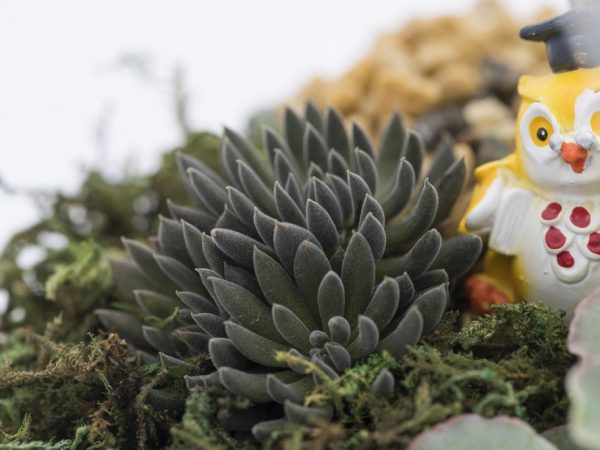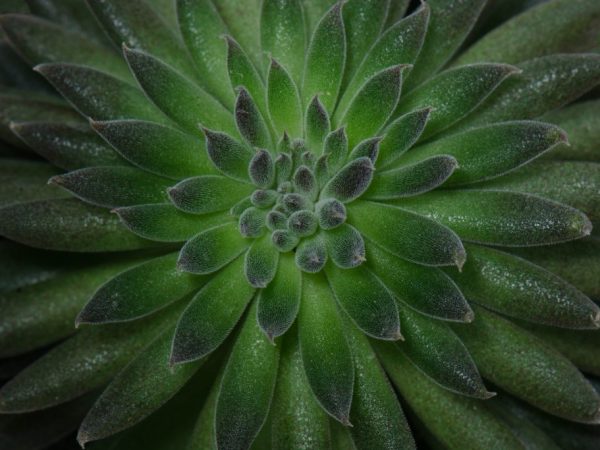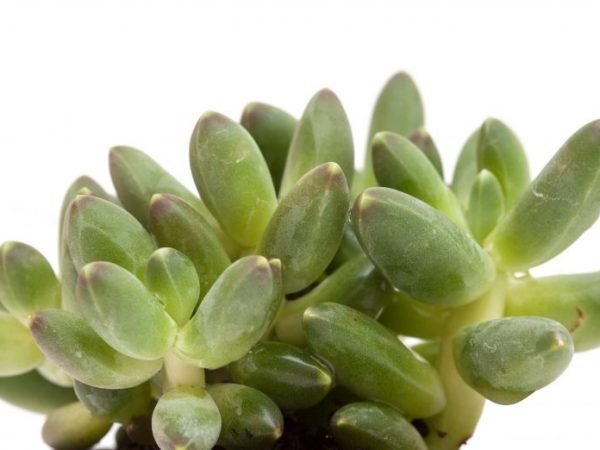Sinokrassula Yunnan - home care
This unusual succulent is originally from China, from the mountainous regions of Yunnan province. Hence the name - Yunnan Sinokrassula. Having got used to harsh conditions in nature - poor soils, low humidity, temperature drops - the plant does not require complex care.

Sinokrassula Yunnan - home care
Description of the species
Sinokrassula is a low-growing plant with basal rosettes in the form of stars from fleshy triangular leaves. Although there are seven types of synokrassula in nature, only two of them are grown in the conditions of apartments - Yunnan and Densirosulata.
The succulent is ground cover, the leaves form curtains, giving it a decorative effect.
It blooms rarely with small white bells, gathered in a panicle on a long peduncle. It can be grown outdoors and used as an element of landscape design.
Planting and transplanting
The first transplant is required immediately after purchase. In the future, if the pot is chosen correctly, the succulent can be transplanted once every 3 years, an adult plant even less often.
It is important that the flowerpot is spacious - low and wide. So it will be easier for the synokrassula to grow in different directions.
Soil for succulents needs a special one, with a predominance of coarse sand and gravel, which is easily permeable to moisture. The main thing for sinokrassula is good drainage. Expanded clay is placed in the pot in the first layer, then finer vermiculite, and only on top - nutritious soil mixed with foam and gravel. The more leavening agents in the soil, the better.
Fine construction sand is not suitable for lightening the substrate! It will make it harder for moisture to penetrate and prevent the succulent roots from breathing normally.
Purchase and adaptation
Immediately after purchase, the plant should be carefully examined. Even if it looks healthy, quarantine is necessary. Succulents are often infested with root nematodes or root thrips. Therefore, after 1-2 weeks of adaptation to the microclimate, it is better to transplant it into another container with new soil.
Another reason for replanting after purchase is the peat mixture into which the succulents are placed for sale. It is not suitable for their constant growth. After transplanting, the flower is placed in the designated place next to the rest.
Seat selection
The flower will feel great in a room on a south or west window. Free air circulation is encouraged, but drafts are contraindicated for it.
Sometimes sinorassula is planted with others as a ground cover. Having entered into symbiosis with each other, they will grow well together.
Necessary microclimate
Humidity
Succulents prefer dry climates. They are never sprayed or placed next to trays of water. Excessive moisture leads to illness. The most dangerous of these is root rot.But even a simple weakening of immunity for a flower is unpleasant - the synokrassula will stop growing, begin to wither and lose its decorative effect.
Temperature
In summer, the succulent needs a temperature of + 22-25 ° C. In autumn, when the dormant period begins, it must be reduced to + 16-18 ° С.
It is better to rearrange the pot to a cooler room. The minimum wintering temperature is + 10 ° С. The flower can withstand a short-term drop to +5 ° C, but it is better not to carry out such experiments.
The main condition for the correct wintering of synokrassula is the difference between day and night temperatures. It should differ by 4-6 ° C.
A plant that is well rested during the winter will take on better growth in the spring and will be healthier, new sockets and peduncles will appear, and the lifespan will increase.
Lighting

Sinokrassula needs a lot of light
All succulents require a lot of light. With its lack, they stretch, and in the case of synokrassula, this is unacceptable. All beauty will be lost if the flower begins to thin out and stretch upward. It is better not to bring it to this, choosing for him the brightest place in the house.
Sinokrassula is not subject to burns and is well tolerated by direct rays. In summer, the plant can even be taken out into the garden in a sunny place. It will gain strength and grow better. The main thing is to make sure that the flowerpot is not flooded with rain.
Home care
All fat women are not too whimsical, but there are general rules for their maintenance. Even such a "unkillable" plant can be ruined if you do not follow them.
If you create suitable conditions for sinokrassula, it will delight you with beauty for many years. They are true centenarians, capable of growing for over 50 years.
Watering
All fatty plants are watered moderately, infrequently. The flower is able to do without water for a long time, using nutrients from the fleshy leaves. It is better to underfill it than to oversaturate it with moisture. Then rotting of the roots will not be avoided.
Water for irrigation must first be defended. It should be at room temperature, not cold.
You should never water synokrassula with tap water - due to excess chlorine, it will not be absorbed by the weak roots of the succulent.
Top dressing
With all the unpretentiousness of the synokrassula, it needs additional feeding. They are brought in from spring to late summer, when the plant has an active period of growth and flowering.
There are many mineral complexes for succulents in which the correct proportions of nitrogen, potassium and phosphorus, etc. are already selected.
Such drugs have proven themselves well as:
- Stimovit;
- Good Power;
- Pokon;
- Gilea;
- Fertis.
It is a liquid root fertilizer, most suitable for synocrassula. It is not recommended to add organic matter. Excessive nitrogen in them can lead to rotting.
Reproduction methods
The Yunnan sinokrassula is propagated in three ways. Each of them has advantages and features. Succulent is easy to propagate if you follow all the rules.
Seeds
Seeds are sown in vermiculite or coarse sand, sprinkling a little on top. Cover the container with film or glass and place it under an incandescent lamp.
It both warms and gives the sprouts the necessary light. At a temperature of 27-30 ° C, the seeds will germinate in 2 weeks. After 2 months, they can be planted in separate pots.
Cuttings
Scheme: tear off a leaf, put it to dry for 2-3 days, then dip it in Kornevin and plant it in the substrate.
Be sure to make a greenhouse by covering the stalk with a glass or jar. Keep warm at a temperature of 25-28 ° C. The leaf will take root in 2-3 weeks.
By dividing an adult plant

An adult plant can be divided
When transplanting, you can divide the thickened plant into several parts. It is desirable that each part has a root system. By placing the segments in separate pots and placing them in a warm place, the succulents will harden and begin to grow.
This method allows you to get independent adult sockets in a few weeks.
Diseases and pests
| Symptoms | Treatment | Prevention | |
| Root rot | The leaves wither, become soft, the stem rots | At the initial stage, transplant into a new dry substrate | Do not pour succulent |
| Brown spot | Brown spots on the leaves | Fitosporin-M, Gamair, Vectra | Lots of light, don't flood |
| Fusarium | Rusty streaks from the root up the trunk | Cut out rust, preparations: Fitosporin-M, Trichovit, Fitolavin | Regular inspection, correct watering and lighting |
| Shield | Brown growths on leaves | Aktara, Actellic, Confidor, Extra | Regular inspection |
| Mealybug | White fluffy bloom from the inside of the leaf | Aktara, Confidor, | Regular inspection |
| Spider mite | Cobweb in the axils of the leaves | Akarin, Anti-tick, Fitoverm | Regular inspection |
| Thrips | Sticky brown spots and streaks | Aktellik, Aktara, Mospilan | Regular inspection |
Sinokrassula is an unusual and unpretentious plant, a real decoration of the home collection of succulents. With a properly selected watering regime, lighting, feeding and timely transplantation, the plant will delight with its decorative effect for many years.

